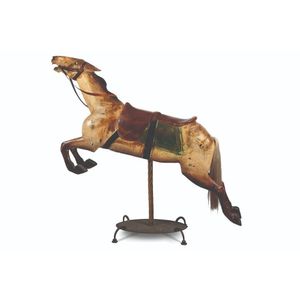Exquisite Illions Carved Carousel Horse: American Masterpiece, Circa 1910
An exceptional carved, painted and lacquered gesso timber carousel jumping horse, American, circa 1910, attributed to Marcus Illions, with integral double saddle, metal shoes, and on a later brass and iron stand, 187 cm high, 200 cm wide, 35 cm deep. Note: Marcus Illions (1871-1949) was a master carver of wooden carousel horses and other menagerie figures. Emigrating from England to America, he worked briefly as a carver before establishing his own business, M.C Illions & Sons Carousell (sic) works. Known for his Coney Island style of figure, his horses are energetic and powerful. This spirited jumping horse is probably a Derby racer., 18.3 hands (186 cm) high, 260 cm wide
You must be a subscriber, and be logged in to view price and dealer details.
Subscribe Now to view actual auction price for this item
When you subscribe, you have the option of setting the currency in which to display prices to $Au, $US, $NZ or Stg.
This item has been sold, and the description, image and price are for reference purposes only.
- Gesso - A mixture of plaster of Paris and gypsum mixed with water and then applied to the carved wooden frames of mirrors and picture frames as a base for applying gold leaf. After numerous coats of gesso have been applied, allowed to dry and then sanded a coat of "bole", a usually red coloured mixture of clay and glue is brushed on and allowed to dry, after which the gold leaf is applied. In painting, gesso is also used to prime a canvas prior to applying paint.
- Manner of .... / Style of ..... - A cataloguing term where the item, in the opinion of the cataloguer is a work in the style of the artist, craftsman or designer, possibly of a later period.
- Attributed - A cataloguing term where the item in the opinion of the cataloguers, is a of the period of the artist, craftsman or designer, and which probably in whole or part is the work of that person.
- Circa - A Latin term meaning 'about', often used in the antique trade to give an approximate date for the piece, usually considered to be five years on either side of the circa year. Thus, circa 1900 means the piece was made about 1900, probably between 1895 and 1905. The expression is sometimes abbreviated to c.1900.
This item has been included into following indexes:
